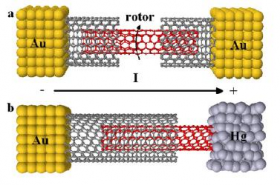July 8, 2008 feature
Carbon Nanotube Windmills Powered by 'Electron Wind'

Theoretical physicists from Lancaster University in the UK have designed a nanomotor that operates by a novel mechanism: an electron wind.
As Steven Bailey, Ilias Amanatidis, and Colin Lambert explain in a recent issue of Physical Review Letters, the new drive mechanism could be useful for future NEMS (nanoelectromechanical structures) technologies.
“[Previously,] thoughts have been directed towards ‘pushing’ the motor to make it turn, whereas our suggestion harnesses an intrinsic property of the device: the change in momentum of electrons or phonons, for example,” Bailey told PhysOrg.com.
The researchers describe the proposed nanomotor as a carbon nanotube (CNT) windmill, although the device looks more like a telescope than the conventional spinning blades of a windmill. It consists of a double-walled CNT, where the outer tube is clamped to two external electrodes, and the shorter inner tube is free to move and rotate. In a version called the CNT drill, the outer tube is clamped to just one electrode, while one end of the free inner tube is in contact with a mercury electrode, but is still free to rotate. The devices are called windmills because they’re powered by an applied dc voltage between the electrodes, which produces a “wind” of electrons.
As it moves through the CNT, the flow of electrons acquires angular momentum, producing a tangential force that causes the inner nanotube to rotate. The researchers calculated that the electron wind can produce a force that significantly exceeds the inter-wall friction – sometimes by as much as three orders of magnitude. Depending on the applied voltage, the rotating inner tube can reach CNT breakdown velocities of up to 8,000 meters per second.
The electron-wind-powered nanomotor could have a range of applications. For instance, by using a voltage pulse to make the inner tube rotate at a specific angle, it could be used as a switch or memory element in nanoscale magnetic memory devices; or, by putting the CNT in contact with a reservoir of atoms or molecules, the nanomotor could act as a nanofluidic pump.
The physicists also suggest that the motor could be powered in different ways. In one possibility, the electrodes could be replaced with reservoirs of atoms or molecules. Then, an applied pressure difference could drive the atoms or molecules across the CNT, and their angular momentum could cause the inner tube to rotate. Similarly, a temperature difference between the ends of the CNT could create a flux of phonons that could also drive the motor.
Other CNT-based nanomotors have been developed, including multi-walled CNTs with a similar structure to the CNT windmill. However, these previous designs have been powered by electrostatic forces that require metallic plates and gates, which aren’t needed in the new design. The researchers hope that the efficiency and simplicity of the CNT windmills will provide advantages over electrostatic and other nanomotors in the future.
“The capability to engineer nanoscale motors is at the same stage as that of microscale motors in the 1990s,” Bailey said. “The manufacturing techniques to deal with the very low dimensions are always playing catch up with experimental groups, which are making very rapid progress, and we predict that to test out the CNT windmill will not require much change to established procedures within these groups. Indeed, there should be much less construction involved in making the nanomotor devices. The engineering simplicity of the CNT windmill will be the greatest advantage in the future.”
More information: Bailey, S.W.D; Amanatidis, I.; and Lambert, C.J. “Carbon Nanotube Electron Windmills: A Novel Design for Nanomotors.” Physical Review Letters 100, 256802 (2008).
Copyright 2008 PhysOrg.com.
All rights reserved. This material may not be published, broadcast, rewritten or redistributed in whole or part without the express written permission of PhysOrg.com.





















